MGT726 Managerial Project: Investigating Employee Motivation Factors
VerifiedAdded on 2023/06/07
|19
|4134
|59
Report
AI Summary
This managerial project report investigates the critical issue of employee demotivation within organizations, focusing on identifying demotivation factors and their impacts. The research employs a qualitative approach, utilizing semi-structured interviews to gather data from employees. Key findings reveal a lack of effective communication between management and staff, as well as poor peer and supervisor relationships, contributing to job insecurity and low morale. The report explores the negative consequences of these factors, including poor alignment of expectations, hostility, and decreased risk-taking among employees. Herzberg's two-factor model is used as a theoretical framework to understand the dynamics of motivation and dissatisfaction. The proposed analysis of results aims to provide insights into addressing these issues and improving employee motivation. Desklib provides a platform for students to access this and other solved assignments and past papers.
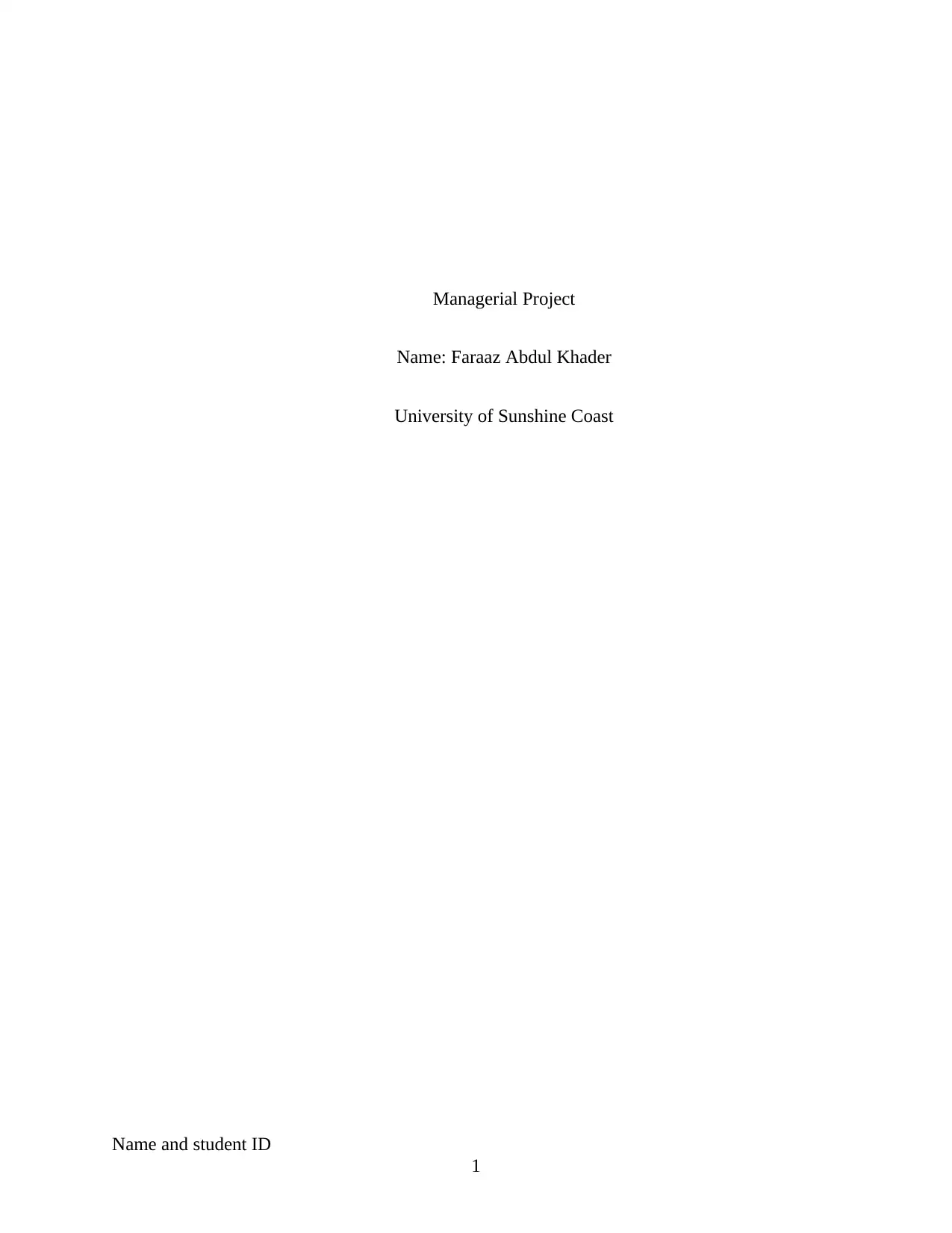
Managerial Project
Name: Faraaz Abdul Khader
University of Sunshine Coast
Name and student ID
1
Name: Faraaz Abdul Khader
University of Sunshine Coast
Name and student ID
1
Paraphrase This Document
Need a fresh take? Get an instant paraphrase of this document with our AI Paraphraser

Executive Summary
The purpose of this assignment is to outline the progress to date and the indication of the analysis
and evaluation to be integrated in the final report. The management problem identified is lack of
motivation of employees in an organization. This is justified by the high number of complaints in
the employment sector due to demotivation factors. In the research question and objectives will
state the statement of research question and further give the research objectives.
Name and student ID
2
The purpose of this assignment is to outline the progress to date and the indication of the analysis
and evaluation to be integrated in the final report. The management problem identified is lack of
motivation of employees in an organization. This is justified by the high number of complaints in
the employment sector due to demotivation factors. In the research question and objectives will
state the statement of research question and further give the research objectives.
Name and student ID
2

Tables of Contents
Executive Summary………………………………………………………………………………………………………………….…i
List of Figures…………………………………………………………………………………………………………………………...iii
List of Tables……………………………………………………………………………………………………………………….…….iv
List of Abbreviations…………………………………………………………………………………………………………………..v
1. Introduction.........................................................................................................................................5
1.1 Purpose..............................................................................................................................................6
1.2 Background and significance.............................................................................................................6
1.3 Research question and objectives......................................................................................................6
1.4 Research boundaries..........................................................................................................................7
1.5 Report outline....................................................................................................................................7
2 Literature review/theoretical framework...............................................................................................7
2.1 Introduction.................................................................................................................................8
2.2 Topic 1.........................................................................................................................................8
3 Methodology........................................................................................................................................8
3.1 Introduction.......................................................................................................................................9
3.1 Research approach and justification..................................................................................................9
3.3 Details of specific data collection techniques..................................................................................10
4 Proposed analysis of results................................................................................................................14
5 Conclusion..........................................................................................................................................15
6 References..............................................................................................................................................16
Name and student ID
3
Executive Summary………………………………………………………………………………………………………………….…i
List of Figures…………………………………………………………………………………………………………………………...iii
List of Tables……………………………………………………………………………………………………………………….…….iv
List of Abbreviations…………………………………………………………………………………………………………………..v
1. Introduction.........................................................................................................................................5
1.1 Purpose..............................................................................................................................................6
1.2 Background and significance.............................................................................................................6
1.3 Research question and objectives......................................................................................................6
1.4 Research boundaries..........................................................................................................................7
1.5 Report outline....................................................................................................................................7
2 Literature review/theoretical framework...............................................................................................7
2.1 Introduction.................................................................................................................................8
2.2 Topic 1.........................................................................................................................................8
3 Methodology........................................................................................................................................8
3.1 Introduction.......................................................................................................................................9
3.1 Research approach and justification..................................................................................................9
3.3 Details of specific data collection techniques..................................................................................10
4 Proposed analysis of results................................................................................................................14
5 Conclusion..........................................................................................................................................15
6 References..............................................................................................................................................16
Name and student ID
3
⊘ This is a preview!⊘
Do you want full access?
Subscribe today to unlock all pages.

Trusted by 1+ million students worldwide

List of Figures
None
List of Tables
None
List of Abbreviations
None
1. Introduction
1.1 Purpose
Name and student ID
4
None
List of Tables
None
List of Abbreviations
None
1. Introduction
1.1 Purpose
Name and student ID
4
Paraphrase This Document
Need a fresh take? Get an instant paraphrase of this document with our AI Paraphraser
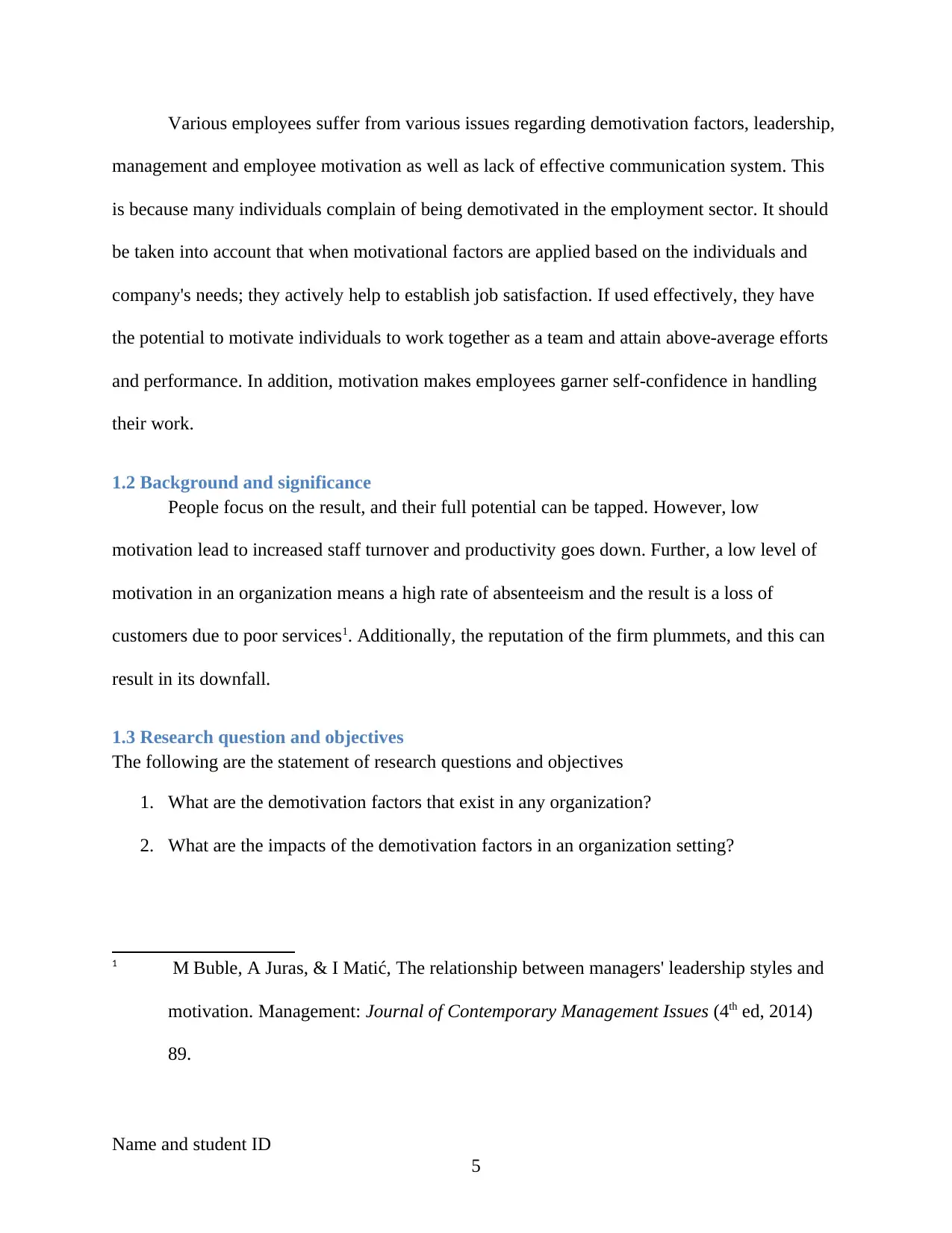
Various employees suffer from various issues regarding demotivation factors, leadership,
management and employee motivation as well as lack of effective communication system. This
is because many individuals complain of being demotivated in the employment sector. It should
be taken into account that when motivational factors are applied based on the individuals and
company's needs; they actively help to establish job satisfaction. If used effectively, they have
the potential to motivate individuals to work together as a team and attain above-average efforts
and performance. In addition, motivation makes employees garner self-confidence in handling
their work.
1.2 Background and significance
People focus on the result, and their full potential can be tapped. However, low
motivation lead to increased staff turnover and productivity goes down. Further, a low level of
motivation in an organization means a high rate of absenteeism and the result is a loss of
customers due to poor services1. Additionally, the reputation of the firm plummets, and this can
result in its downfall.
1.3 Research question and objectives
The following are the statement of research questions and objectives
1. What are the demotivation factors that exist in any organization?
2. What are the impacts of the demotivation factors in an organization setting?
1 M Buble, A Juras, & I Matić, The relationship between managers' leadership styles and
motivation. Management: Journal of Contemporary Management Issues (4th ed, 2014)
89.
Name and student ID
5
management and employee motivation as well as lack of effective communication system. This
is because many individuals complain of being demotivated in the employment sector. It should
be taken into account that when motivational factors are applied based on the individuals and
company's needs; they actively help to establish job satisfaction. If used effectively, they have
the potential to motivate individuals to work together as a team and attain above-average efforts
and performance. In addition, motivation makes employees garner self-confidence in handling
their work.
1.2 Background and significance
People focus on the result, and their full potential can be tapped. However, low
motivation lead to increased staff turnover and productivity goes down. Further, a low level of
motivation in an organization means a high rate of absenteeism and the result is a loss of
customers due to poor services1. Additionally, the reputation of the firm plummets, and this can
result in its downfall.
1.3 Research question and objectives
The following are the statement of research questions and objectives
1. What are the demotivation factors that exist in any organization?
2. What are the impacts of the demotivation factors in an organization setting?
1 M Buble, A Juras, & I Matić, The relationship between managers' leadership styles and
motivation. Management: Journal of Contemporary Management Issues (4th ed, 2014)
89.
Name and student ID
5

This objective of research is to allow the organization to recognize new concepts regarding
different involvement.
1.4 Research boundaries
Several researchers have already conducted studies and analyses relative to the research
statements. In looking at them, it is likely to gain understanding on several features including
appropriate theories, the causes for demotivation of employees, the adversarial effects that come
with this behaviour, and the kinds of support that are accessible.
1.5 Report outline
In addition, project workforces will get the chance to reflect on policies and diverse
involvement methods that are used with these groups of employees. This consideration will make
them better at the organization where they work in and can recognize the strengths that need to
continue in addition to problem solving in the areas that need more strength.
2 Literature review/theoretical framework
Herzberg's two-factor model comprises hygiene factors that are not meant to increase
motivation but are essential for preventing dissatisfaction among employees2. According to this
theory, motivational factors are those that would lead to improved performance to the highest
level possible. On the other hand, hygiene factors depended on the needs of an organization or
business which help to reduce or avoid unpleasantness at work. Herzberg contends that intrinsic
2 C Cerasoli, J Nicklin & M Ford, Intrinsic motivation and extrinsic incentives jointly
predict performance: A 40-year meta-analysis. Psychological Bulletin, (4th ed, 2014) 45.
Name and student ID
6
different involvement.
1.4 Research boundaries
Several researchers have already conducted studies and analyses relative to the research
statements. In looking at them, it is likely to gain understanding on several features including
appropriate theories, the causes for demotivation of employees, the adversarial effects that come
with this behaviour, and the kinds of support that are accessible.
1.5 Report outline
In addition, project workforces will get the chance to reflect on policies and diverse
involvement methods that are used with these groups of employees. This consideration will make
them better at the organization where they work in and can recognize the strengths that need to
continue in addition to problem solving in the areas that need more strength.
2 Literature review/theoretical framework
Herzberg's two-factor model comprises hygiene factors that are not meant to increase
motivation but are essential for preventing dissatisfaction among employees2. According to this
theory, motivational factors are those that would lead to improved performance to the highest
level possible. On the other hand, hygiene factors depended on the needs of an organization or
business which help to reduce or avoid unpleasantness at work. Herzberg contends that intrinsic
2 C Cerasoli, J Nicklin & M Ford, Intrinsic motivation and extrinsic incentives jointly
predict performance: A 40-year meta-analysis. Psychological Bulletin, (4th ed, 2014) 45.
Name and student ID
6
⊘ This is a preview!⊘
Do you want full access?
Subscribe today to unlock all pages.

Trusted by 1+ million students worldwide
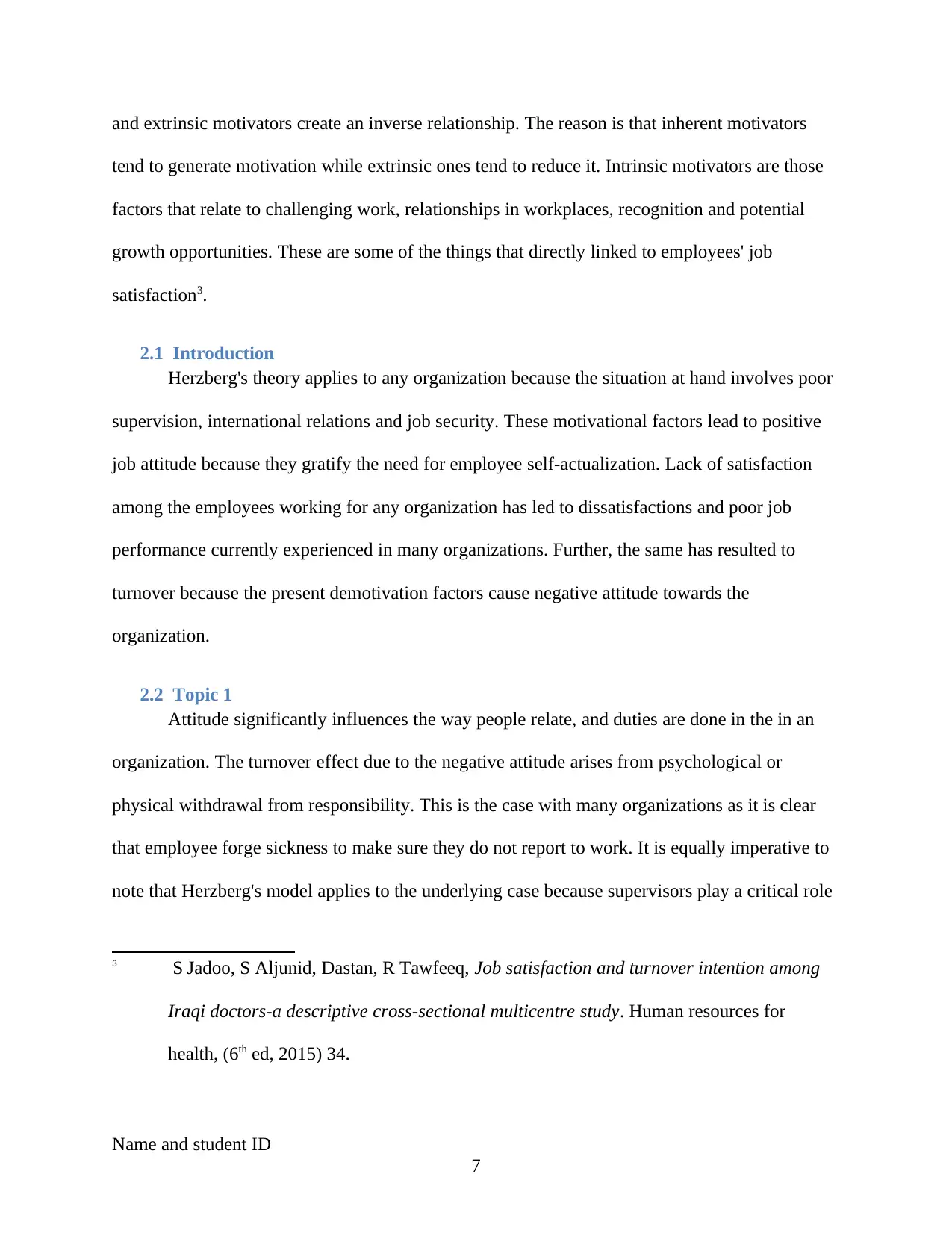
and extrinsic motivators create an inverse relationship. The reason is that inherent motivators
tend to generate motivation while extrinsic ones tend to reduce it. Intrinsic motivators are those
factors that relate to challenging work, relationships in workplaces, recognition and potential
growth opportunities. These are some of the things that directly linked to employees' job
satisfaction3.
2.1 Introduction
Herzberg's theory applies to any organization because the situation at hand involves poor
supervision, international relations and job security. These motivational factors lead to positive
job attitude because they gratify the need for employee self-actualization. Lack of satisfaction
among the employees working for any organization has led to dissatisfactions and poor job
performance currently experienced in many organizations. Further, the same has resulted to
turnover because the present demotivation factors cause negative attitude towards the
organization.
2.2 Topic 1
Attitude significantly influences the way people relate, and duties are done in the in an
organization. The turnover effect due to the negative attitude arises from psychological or
physical withdrawal from responsibility. This is the case with many organizations as it is clear
that employee forge sickness to make sure they do not report to work. It is equally imperative to
note that Herzberg's model applies to the underlying case because supervisors play a critical role
3 S Jadoo, S Aljunid, Dastan, R Tawfeeq, Job satisfaction and turnover intention among
Iraqi doctors-a descriptive cross-sectional multicentre study. Human resources for
health, (6th ed, 2015) 34.
Name and student ID
7
tend to generate motivation while extrinsic ones tend to reduce it. Intrinsic motivators are those
factors that relate to challenging work, relationships in workplaces, recognition and potential
growth opportunities. These are some of the things that directly linked to employees' job
satisfaction3.
2.1 Introduction
Herzberg's theory applies to any organization because the situation at hand involves poor
supervision, international relations and job security. These motivational factors lead to positive
job attitude because they gratify the need for employee self-actualization. Lack of satisfaction
among the employees working for any organization has led to dissatisfactions and poor job
performance currently experienced in many organizations. Further, the same has resulted to
turnover because the present demotivation factors cause negative attitude towards the
organization.
2.2 Topic 1
Attitude significantly influences the way people relate, and duties are done in the in an
organization. The turnover effect due to the negative attitude arises from psychological or
physical withdrawal from responsibility. This is the case with many organizations as it is clear
that employee forge sickness to make sure they do not report to work. It is equally imperative to
note that Herzberg's model applies to the underlying case because supervisors play a critical role
3 S Jadoo, S Aljunid, Dastan, R Tawfeeq, Job satisfaction and turnover intention among
Iraqi doctors-a descriptive cross-sectional multicentre study. Human resources for
health, (6th ed, 2015) 34.
Name and student ID
7
Paraphrase This Document
Need a fresh take? Get an instant paraphrase of this document with our AI Paraphraser
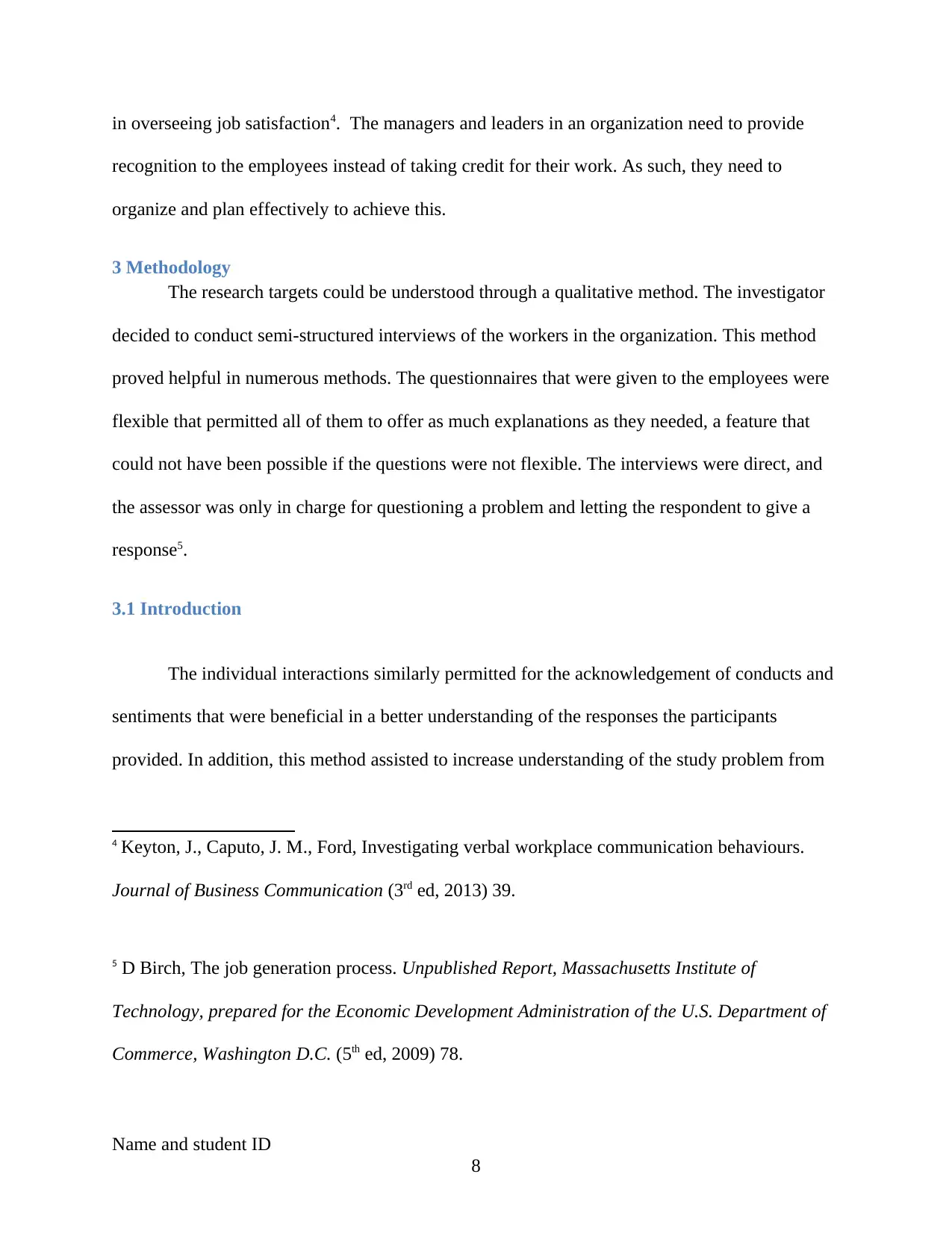
in overseeing job satisfaction4. The managers and leaders in an organization need to provide
recognition to the employees instead of taking credit for their work. As such, they need to
organize and plan effectively to achieve this.
3 Methodology
The research targets could be understood through a qualitative method. The investigator
decided to conduct semi-structured interviews of the workers in the organization. This method
proved helpful in numerous methods. The questionnaires that were given to the employees were
flexible that permitted all of them to offer as much explanations as they needed, a feature that
could not have been possible if the questions were not flexible. The interviews were direct, and
the assessor was only in charge for questioning a problem and letting the respondent to give a
response5.
3.1 Introduction
The individual interactions similarly permitted for the acknowledgement of conducts and
sentiments that were beneficial in a better understanding of the responses the participants
provided. In addition, this method assisted to increase understanding of the study problem from
4 Keyton, J., Caputo, J. M., Ford, Investigating verbal workplace communication behaviours.
Journal of Business Communication (3rd ed, 2013) 39.
5 D Birch, The job generation process. Unpublished Report, Massachusetts Institute of
Technology, prepared for the Economic Development Administration of the U.S. Department of
Commerce, Washington D.C. (5th ed, 2009) 78.
Name and student ID
8
recognition to the employees instead of taking credit for their work. As such, they need to
organize and plan effectively to achieve this.
3 Methodology
The research targets could be understood through a qualitative method. The investigator
decided to conduct semi-structured interviews of the workers in the organization. This method
proved helpful in numerous methods. The questionnaires that were given to the employees were
flexible that permitted all of them to offer as much explanations as they needed, a feature that
could not have been possible if the questions were not flexible. The interviews were direct, and
the assessor was only in charge for questioning a problem and letting the respondent to give a
response5.
3.1 Introduction
The individual interactions similarly permitted for the acknowledgement of conducts and
sentiments that were beneficial in a better understanding of the responses the participants
provided. In addition, this method assisted to increase understanding of the study problem from
4 Keyton, J., Caputo, J. M., Ford, Investigating verbal workplace communication behaviours.
Journal of Business Communication (3rd ed, 2013) 39.
5 D Birch, The job generation process. Unpublished Report, Massachusetts Institute of
Technology, prepared for the Economic Development Administration of the U.S. Department of
Commerce, Washington D.C. (5th ed, 2009) 78.
Name and student ID
8
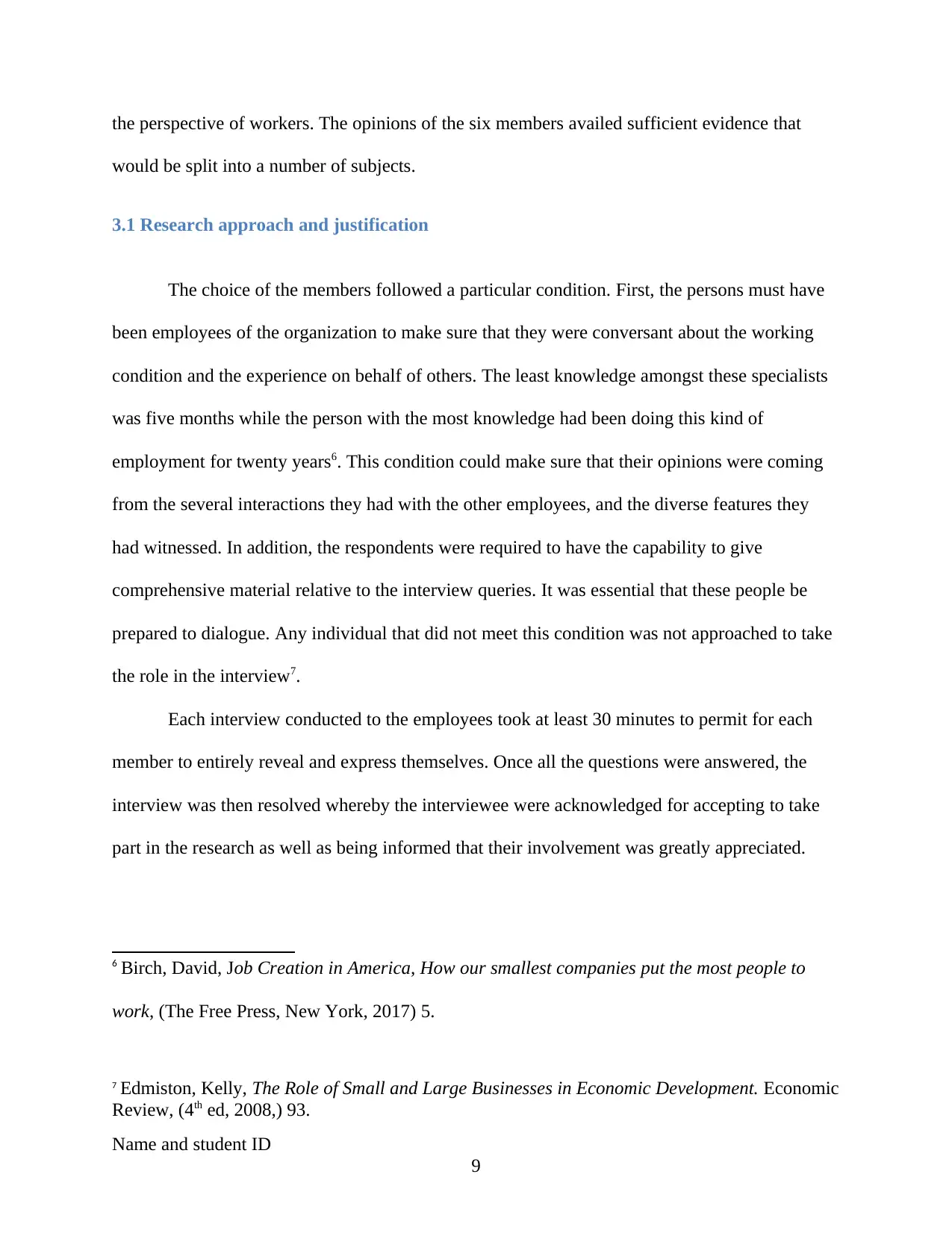
the perspective of workers. The opinions of the six members availed sufficient evidence that
would be split into a number of subjects.
3.1 Research approach and justification
The choice of the members followed a particular condition. First, the persons must have
been employees of the organization to make sure that they were conversant about the working
condition and the experience on behalf of others. The least knowledge amongst these specialists
was five months while the person with the most knowledge had been doing this kind of
employment for twenty years6. This condition could make sure that their opinions were coming
from the several interactions they had with the other employees, and the diverse features they
had witnessed. In addition, the respondents were required to have the capability to give
comprehensive material relative to the interview queries. It was essential that these people be
prepared to dialogue. Any individual that did not meet this condition was not approached to take
the role in the interview7.
Each interview conducted to the employees took at least 30 minutes to permit for each
member to entirely reveal and express themselves. Once all the questions were answered, the
interview was then resolved whereby the interviewee were acknowledged for accepting to take
part in the research as well as being informed that their involvement was greatly appreciated.
6 Birch, David, Job Creation in America, How our smallest companies put the most people to
work, (The Free Press, New York, 2017) 5.
7 Edmiston, Kelly, The Role of Small and Large Businesses in Economic Development. Economic
Review, (4th ed, 2008,) 93.
Name and student ID
9
would be split into a number of subjects.
3.1 Research approach and justification
The choice of the members followed a particular condition. First, the persons must have
been employees of the organization to make sure that they were conversant about the working
condition and the experience on behalf of others. The least knowledge amongst these specialists
was five months while the person with the most knowledge had been doing this kind of
employment for twenty years6. This condition could make sure that their opinions were coming
from the several interactions they had with the other employees, and the diverse features they
had witnessed. In addition, the respondents were required to have the capability to give
comprehensive material relative to the interview queries. It was essential that these people be
prepared to dialogue. Any individual that did not meet this condition was not approached to take
the role in the interview7.
Each interview conducted to the employees took at least 30 minutes to permit for each
member to entirely reveal and express themselves. Once all the questions were answered, the
interview was then resolved whereby the interviewee were acknowledged for accepting to take
part in the research as well as being informed that their involvement was greatly appreciated.
6 Birch, David, Job Creation in America, How our smallest companies put the most people to
work, (The Free Press, New York, 2017) 5.
7 Edmiston, Kelly, The Role of Small and Large Businesses in Economic Development. Economic
Review, (4th ed, 2008,) 93.
Name and student ID
9
⊘ This is a preview!⊘
Do you want full access?
Subscribe today to unlock all pages.

Trusted by 1+ million students worldwide
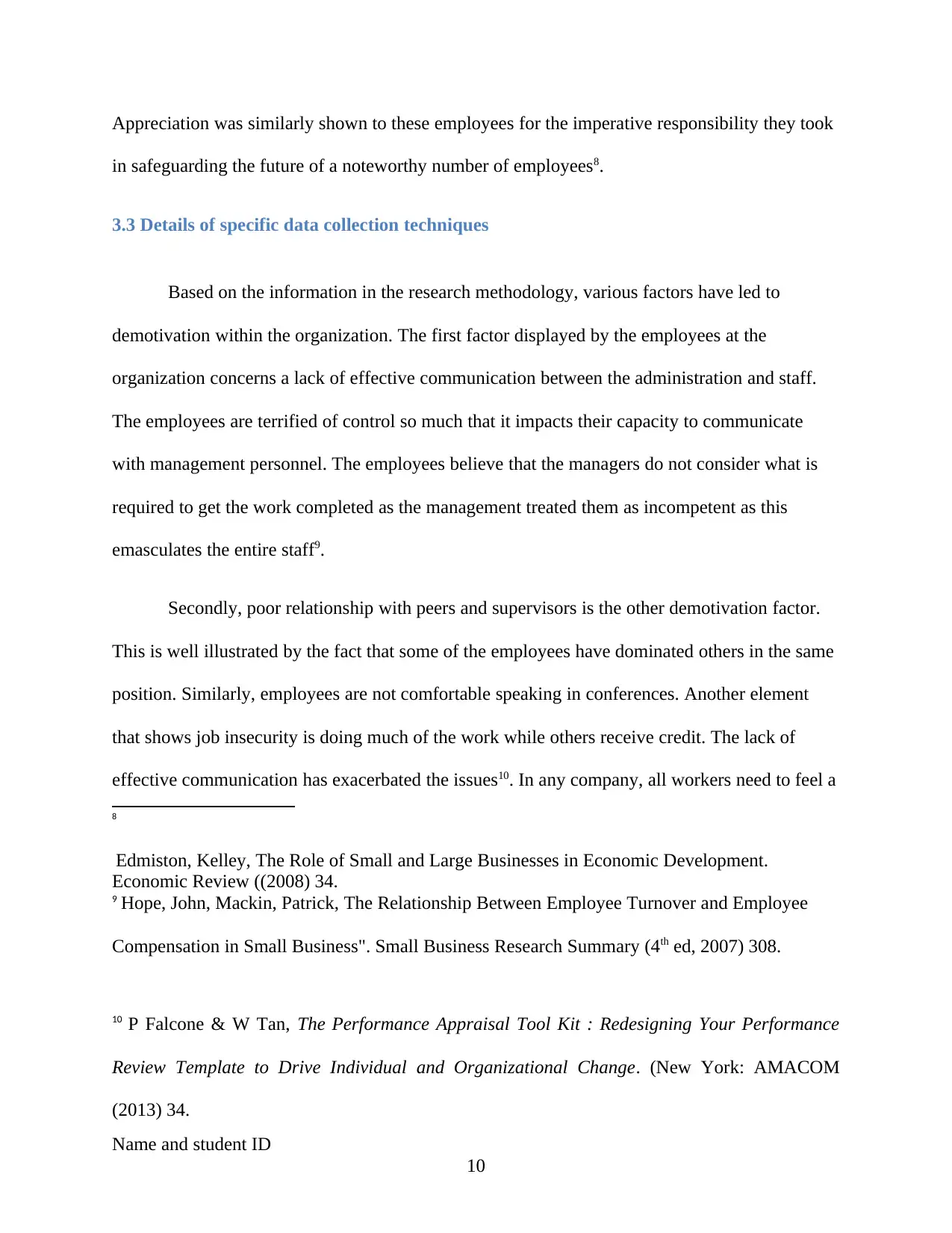
Appreciation was similarly shown to these employees for the imperative responsibility they took
in safeguarding the future of a noteworthy number of employees8.
3.3 Details of specific data collection techniques
Based on the information in the research methodology, various factors have led to
demotivation within the organization. The first factor displayed by the employees at the
organization concerns a lack of effective communication between the administration and staff.
The employees are terrified of control so much that it impacts their capacity to communicate
with management personnel. The employees believe that the managers do not consider what is
required to get the work completed as the management treated them as incompetent as this
emasculates the entire staff9.
Secondly, poor relationship with peers and supervisors is the other demotivation factor.
This is well illustrated by the fact that some of the employees have dominated others in the same
position. Similarly, employees are not comfortable speaking in conferences. Another element
that shows job insecurity is doing much of the work while others receive credit. The lack of
effective communication has exacerbated the issues10. In any company, all workers need to feel a
8
Edmiston, Kelley, The Role of Small and Large Businesses in Economic Development.
Economic Review ((2008) 34.
9 Hope, John, Mackin, Patrick, The Relationship Between Employee Turnover and Employee
Compensation in Small Business". Small Business Research Summary (4th ed, 2007) 308.
10 P Falcone & W Tan, The Performance Appraisal Tool Kit : Redesigning Your Performance
Review Template to Drive Individual and Organizational Change. (New York: AMACOM
(2013) 34.
Name and student ID
10
in safeguarding the future of a noteworthy number of employees8.
3.3 Details of specific data collection techniques
Based on the information in the research methodology, various factors have led to
demotivation within the organization. The first factor displayed by the employees at the
organization concerns a lack of effective communication between the administration and staff.
The employees are terrified of control so much that it impacts their capacity to communicate
with management personnel. The employees believe that the managers do not consider what is
required to get the work completed as the management treated them as incompetent as this
emasculates the entire staff9.
Secondly, poor relationship with peers and supervisors is the other demotivation factor.
This is well illustrated by the fact that some of the employees have dominated others in the same
position. Similarly, employees are not comfortable speaking in conferences. Another element
that shows job insecurity is doing much of the work while others receive credit. The lack of
effective communication has exacerbated the issues10. In any company, all workers need to feel a
8
Edmiston, Kelley, The Role of Small and Large Businesses in Economic Development.
Economic Review ((2008) 34.
9 Hope, John, Mackin, Patrick, The Relationship Between Employee Turnover and Employee
Compensation in Small Business". Small Business Research Summary (4th ed, 2007) 308.
10 P Falcone & W Tan, The Performance Appraisal Tool Kit : Redesigning Your Performance
Review Template to Drive Individual and Organizational Change. (New York: AMACOM
(2013) 34.
Name and student ID
10
Paraphrase This Document
Need a fresh take? Get an instant paraphrase of this document with our AI Paraphraser
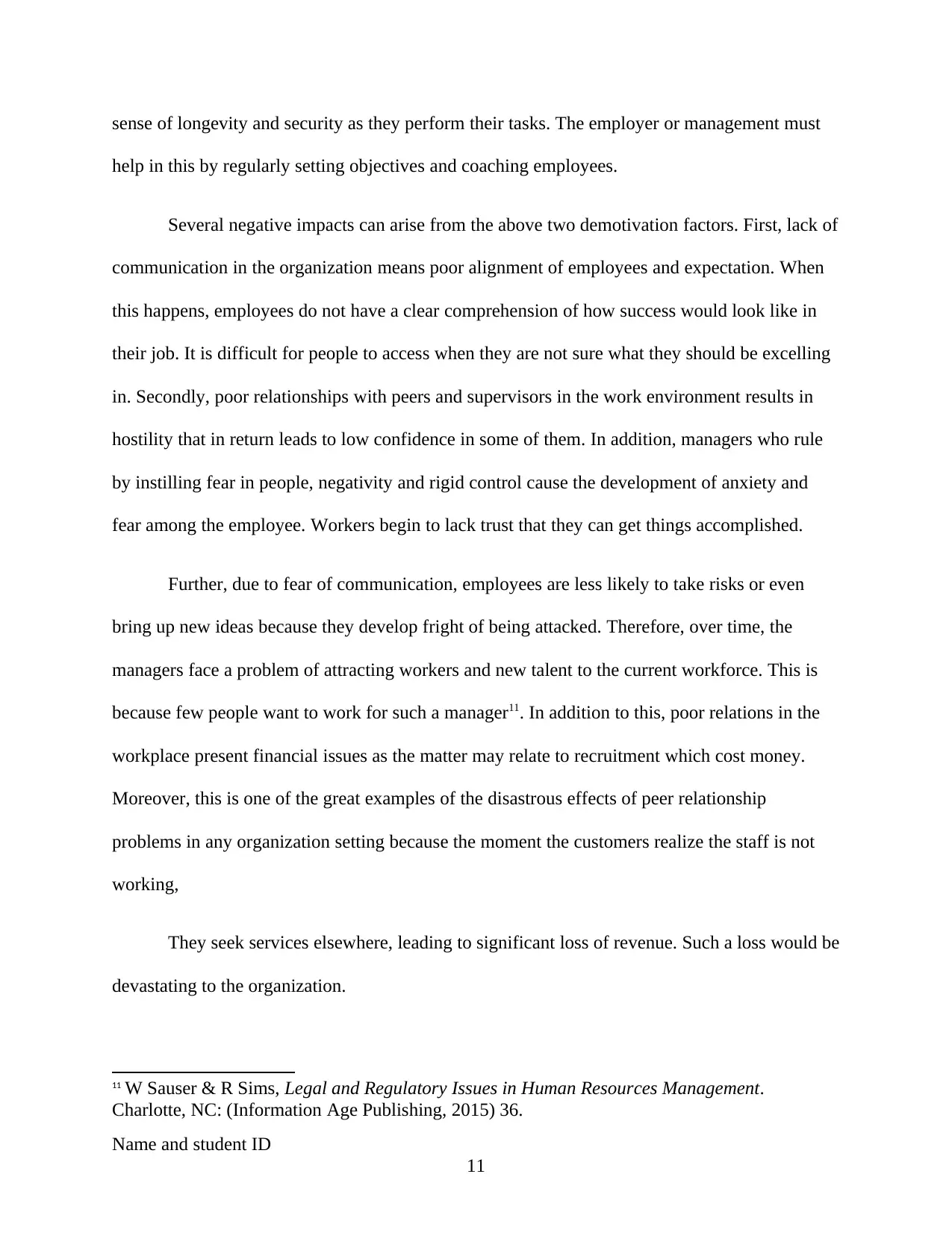
sense of longevity and security as they perform their tasks. The employer or management must
help in this by regularly setting objectives and coaching employees.
Several negative impacts can arise from the above two demotivation factors. First, lack of
communication in the organization means poor alignment of employees and expectation. When
this happens, employees do not have a clear comprehension of how success would look like in
their job. It is difficult for people to access when they are not sure what they should be excelling
in. Secondly, poor relationships with peers and supervisors in the work environment results in
hostility that in return leads to low confidence in some of them. In addition, managers who rule
by instilling fear in people, negativity and rigid control cause the development of anxiety and
fear among the employee. Workers begin to lack trust that they can get things accomplished.
Further, due to fear of communication, employees are less likely to take risks or even
bring up new ideas because they develop fright of being attacked. Therefore, over time, the
managers face a problem of attracting workers and new talent to the current workforce. This is
because few people want to work for such a manager11. In addition to this, poor relations in the
workplace present financial issues as the matter may relate to recruitment which cost money.
Moreover, this is one of the great examples of the disastrous effects of peer relationship
problems in any organization setting because the moment the customers realize the staff is not
working,
They seek services elsewhere, leading to significant loss of revenue. Such a loss would be
devastating to the organization.
11 W Sauser & R Sims, Legal and Regulatory Issues in Human Resources Management.
Charlotte, NC: (Information Age Publishing, 2015) 36.
Name and student ID
11
help in this by regularly setting objectives and coaching employees.
Several negative impacts can arise from the above two demotivation factors. First, lack of
communication in the organization means poor alignment of employees and expectation. When
this happens, employees do not have a clear comprehension of how success would look like in
their job. It is difficult for people to access when they are not sure what they should be excelling
in. Secondly, poor relationships with peers and supervisors in the work environment results in
hostility that in return leads to low confidence in some of them. In addition, managers who rule
by instilling fear in people, negativity and rigid control cause the development of anxiety and
fear among the employee. Workers begin to lack trust that they can get things accomplished.
Further, due to fear of communication, employees are less likely to take risks or even
bring up new ideas because they develop fright of being attacked. Therefore, over time, the
managers face a problem of attracting workers and new talent to the current workforce. This is
because few people want to work for such a manager11. In addition to this, poor relations in the
workplace present financial issues as the matter may relate to recruitment which cost money.
Moreover, this is one of the great examples of the disastrous effects of peer relationship
problems in any organization setting because the moment the customers realize the staff is not
working,
They seek services elsewhere, leading to significant loss of revenue. Such a loss would be
devastating to the organization.
11 W Sauser & R Sims, Legal and Regulatory Issues in Human Resources Management.
Charlotte, NC: (Information Age Publishing, 2015) 36.
Name and student ID
11
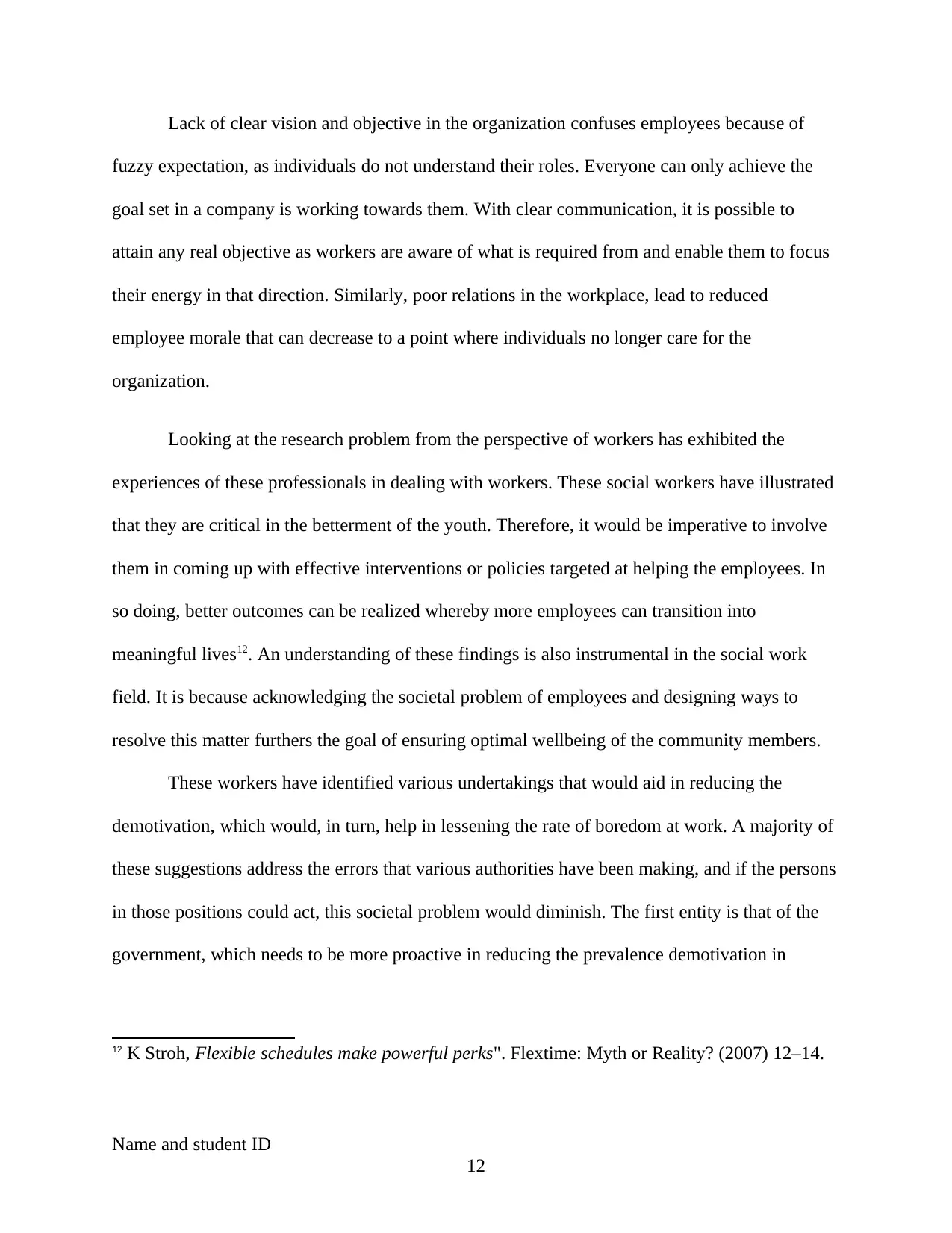
Lack of clear vision and objective in the organization confuses employees because of
fuzzy expectation, as individuals do not understand their roles. Everyone can only achieve the
goal set in a company is working towards them. With clear communication, it is possible to
attain any real objective as workers are aware of what is required from and enable them to focus
their energy in that direction. Similarly, poor relations in the workplace, lead to reduced
employee morale that can decrease to a point where individuals no longer care for the
organization.
Looking at the research problem from the perspective of workers has exhibited the
experiences of these professionals in dealing with workers. These social workers have illustrated
that they are critical in the betterment of the youth. Therefore, it would be imperative to involve
them in coming up with effective interventions or policies targeted at helping the employees. In
so doing, better outcomes can be realized whereby more employees can transition into
meaningful lives12. An understanding of these findings is also instrumental in the social work
field. It is because acknowledging the societal problem of employees and designing ways to
resolve this matter furthers the goal of ensuring optimal wellbeing of the community members.
These workers have identified various undertakings that would aid in reducing the
demotivation, which would, in turn, help in lessening the rate of boredom at work. A majority of
these suggestions address the errors that various authorities have been making, and if the persons
in those positions could act, this societal problem would diminish. The first entity is that of the
government, which needs to be more proactive in reducing the prevalence demotivation in
12 K Stroh, Flexible schedules make powerful perks". Flextime: Myth or Reality? (2007) 12–14.
Name and student ID
12
fuzzy expectation, as individuals do not understand their roles. Everyone can only achieve the
goal set in a company is working towards them. With clear communication, it is possible to
attain any real objective as workers are aware of what is required from and enable them to focus
their energy in that direction. Similarly, poor relations in the workplace, lead to reduced
employee morale that can decrease to a point where individuals no longer care for the
organization.
Looking at the research problem from the perspective of workers has exhibited the
experiences of these professionals in dealing with workers. These social workers have illustrated
that they are critical in the betterment of the youth. Therefore, it would be imperative to involve
them in coming up with effective interventions or policies targeted at helping the employees. In
so doing, better outcomes can be realized whereby more employees can transition into
meaningful lives12. An understanding of these findings is also instrumental in the social work
field. It is because acknowledging the societal problem of employees and designing ways to
resolve this matter furthers the goal of ensuring optimal wellbeing of the community members.
These workers have identified various undertakings that would aid in reducing the
demotivation, which would, in turn, help in lessening the rate of boredom at work. A majority of
these suggestions address the errors that various authorities have been making, and if the persons
in those positions could act, this societal problem would diminish. The first entity is that of the
government, which needs to be more proactive in reducing the prevalence demotivation in
12 K Stroh, Flexible schedules make powerful perks". Flextime: Myth or Reality? (2007) 12–14.
Name and student ID
12
⊘ This is a preview!⊘
Do you want full access?
Subscribe today to unlock all pages.

Trusted by 1+ million students worldwide
1 out of 19
Related Documents
Your All-in-One AI-Powered Toolkit for Academic Success.
+13062052269
info@desklib.com
Available 24*7 on WhatsApp / Email
![[object Object]](/_next/static/media/star-bottom.7253800d.svg)
Unlock your academic potential
Copyright © 2020–2025 A2Z Services. All Rights Reserved. Developed and managed by ZUCOL.




